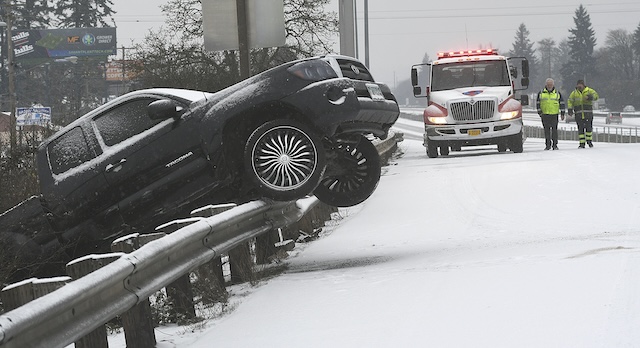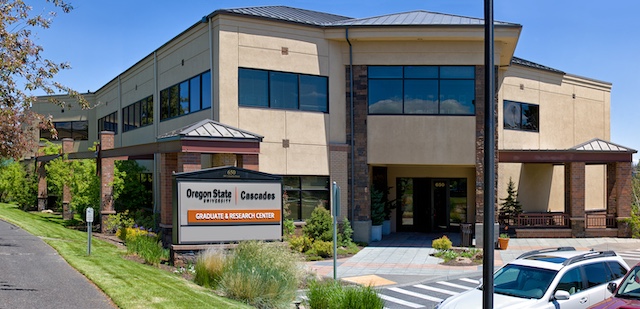Breaching leads to deer trapped in mud, dead fish, sediment-filled water
Published 5:46 pm Thursday, February 1, 2024

- The dewatered reservoir behind Copco 1 near Hornbrook, California, can be seen in this photograph provided Wednesday by the Klamath River Renewal Corp., which is removing the dam and three others on the Klamath River. Drawdown of the reservoir, which began Jan. 23, has sent silt downstream and killed a number of fish, while several deer have become stuck in muck and died.
For five days now, Lynda Leach has grabbed an empty mason jar, stepped outside her home and walked a short distance to the Klamath River to scoop up samples of the muddy water flowing by.
“It’s on our lawn, our lower lawn,” Leach said Thursday in a telephone interview. “It’s black, gunky sediment.”
The river is silt-choked following the breaching of three dams upstream in recent weeks. A fourth dam was removed last year, all in the name of river and fish health.
Leach’s home of 49 years, which she shares with her husband, Jim, a Vietnam-era Army helicopter pilot, is about 2 miles downriver from the Interstate 5 Collier Rest Area near Hornbrook and about 25 miles south of Ashland.
Leach is angry and sad about the silt in the river and the death of deer trapped in the mud flats — both the result of reservoirs behind the dams being drained in preparation for the dams’ removal later this year.
So, to tell her story, she gathers her jars of muddy river water, shakes them up to simulate conditions in the river and sets them out in a row for a daily photograph that she posts to social media.
“Just got this out of the Klamath River, 1/27/24 at 5:13 p.m.,” she wrote on the first day. “And when I walked outside, you can smell it!”
Wednesday was day five — five jars in a row.
“When I take the photo, I shake up each jar so I’m showing the color of the river,” she said in the interview. “It’s not settling in the river, so I’m shaking each jar.”
Some settling, especially of the coarser particles, is expected in the river, but most of the silt in it is expected to flow to the Pacific Ocean, according to a 2022 final environmental impact statement from the Federal Energy Regulatory Commission. As much as 2.4 million tons of sediment will be released due to the drawdown of the four reservoirs and the release of decades of silt collected behind the dams, the assessment says.
“The sediment mobilized from the reservoirs during drawdown is expected to be transported by the river to the ocean mostly as suspended sediment because most of it is predominantly fine-grained composition (silt and clay),” according to the 823-page assessment and related documents. “Sand and coarser material (approximately 16 percent) would be transported more slowly, depending on the frequency and magnitude of flows and storage in the channel bed.”
The Leaches aren’t using their well these days due to possible contamination.
“We’re buying our water,” she said.
They took a drive a few days ago to view the reservoirs behind Iron Gate and Copco 1 dams.
“It was devastating to see what they have done,” she said. “And nobody was saying anything.
“They need to see the river. They need to go up to the lake. They have ruined people’s property values.”
Of the several deer that have died after getting stuck in the muck of the dewatered Copco Lake, Leach said, “It’s the saddest thing I’ve seen in my life.”
The California Department of Fish and Wildlife issued a written statement on Wednesday, saying “nearly a dozen” deer had been trapped in the mud at Copco Lake.
“The public should avoid the area given the dangerous conditions and not attempt to feed or rescue wildlife,” according to the agency. “CDFW is initiating a wildlife management plan in response to ongoing drawdown actions at Copco No. 1 Dam and Iron Gate Reservoir as part of the planned, historic removal of Klamath River dams. This includes increased staffing and wildlife surveys along reservoirs to detect trapped or impacted wildlife.”
Wildlife deterrents are being placed at key locations where animals are likely to enter the areas and options were under consideration to rescue wildlife, according to the statement.
“The stranding of wildlife on muddy reservoir bottoms is an unforeseen situation, one that will improve as temperatures warm in the spring and summer,” the agency said, adding that the deer population in Siskiyou County was healthy and stable overall.
“But we definitely understand the loss of wildlife in this situation is sad and upsetting. We will continue to do all we can.”
Chief Tim Thurner of the Hornbrook Fire Protection District said he was aware of 10 deer dying in the mud — including two dispatched by state wildlife personnel after a failed rescue — and that his agency expected the arrival of rescue sleds Thursday to possibly assist with any rescues. Deer were drowning in mud, he said.
“We won’t really know until we get out there and get some training done,” Thurner wrote in an email Wednesday, referring to the new equipment. “Mud rescue isn’t a common training for firefighters in our area, so we don’t have a great deal of experience with it. There is only a certain degree of risk we can take for wildlife, but our fear is a civilian going into the mud attempting a rescue themselves.”
Thurner wrote, “We had not anticipated animals getting stuck in the mud a 1,000 feet from shore. We are uncertain how they made it that far.”
The district this week received a $1,000 donation from the Wild Horse Fire Brigade to purchase rescue equipment and received another $2,500 from Fall Creek Ranch, he said. He was aware that people were putting out troughs of water so wildlife would not need to cross the mud to the river.
“We understand that the dam removal is a deeply emotional subject, and we hope that we can work together with the community to solve the challenges we face ahead,” he wrote.
The Klamath River Renewal Corp., which is removing the dams, has issued written statements mainly addressing silt in the river, although it commented via social media on a video taken by a resident showing a bird struggling in the mud.
The company reported that biologists saw a “live, wet, mobile, and apparently uninjured” juvenile eagle in brush near a road and reported the sighting to federal and state wildlife authorities. The next day, there was no sign of the eagle.
“As is the case with any restoration project, there are short-term and visible impacts followed by long-term recovery,” the company said in a written statement issued Wednesday. “The environmental analyses necessary to implement this project discussed these impacts in detail, and to date, the project has not had any effects outside the range of what was expected.”
Fluctuations in silt levels are expected for months, if not years, and “significant numbers” of nonnative fish have died, with more deaths expected, according to the Klamath River Renewal Corp. Dissolved oxygen in the river below Iron Gate was 0% on Jan. 27.
“We can also expect some fish mortality downstream as the evacuation of sediment impairs water quality,” the company stated. “Although dead fish have been observed during this short-term event, the majority of salmonids have been able to avoid any impacts as their overwinter habitats are located primarily in tributaries.
“In short, the conditions we are witnessing are as expected. Large-scale river restoration begins with some negative impacts. However, the success of the restoration project cannot be judged by a snapshot from today. The benefits will be revealed in years to come.”
A Klamath River Renewal Corp. newsletter published last year gave this outlook:
“The impacts from dam removal on lower river species are expected to be short term, lasting 1-2 years, with populations recovering from sediment impacts within 5 years. To mitigate the impact of the first sediment flush, KRRC will work in close consultation with state and federal fishery agencies.”
The corporation’s website makes available project documents. Among its postings, the company reports that the sediment is mostly dead algae, clay and fine material the consistency of talcum powder. Going forward, spikes in sediment load are expected this month and in June and July.
Quoting the U.S. Environmental Protection Agency, the company states that the sediment contained “generally low levels of chemical contaminants” and that “the unavoidable release of sediments … would not result in unacceptable adverse impacts . …”
The river will remain cloudier than usual for up to two years after deconstruction is finished, according to the Klamath River Renewal Corp..
“The high turbidity and sharp reduction in dissolved oxygen will have a short-term negative impact on aquatic life as a plume of sediment moves downriver before it washes out to the ocean and dissipates,” the company said.
Restoration efforts, which have already begun, include reseeding and replanting. Deconstruction of the three remaining dams — Iron Gate, Copco 1 and JC Boyle — is expected to be complete by the end of the year. Copco 2 was removed last year.
Iron Gate and the Copco dams are about 20 to 25 miles southeast of Ashland, while JC Boyle is about 15 miles southwest of Klamath Falls. Copco 1, built in 1918, is the oldest, while Iron Gate, built in 1962, is the youngest.
Overall, the dam removals will expose about 2,200 acres of reservoir beds that will be restored over a multiyear process. Upwards of 17 billion seeds have been collected for reseeding.
The primary goal of the dam removals is to restore fish passage and improve water quality. The estimated cost of the dam removal and restoration is $450 million, with a $50 million contingency fund. The cost is funded through a $200-million surcharge on PacifiCorp and $250 million in bonds from the state of California.








